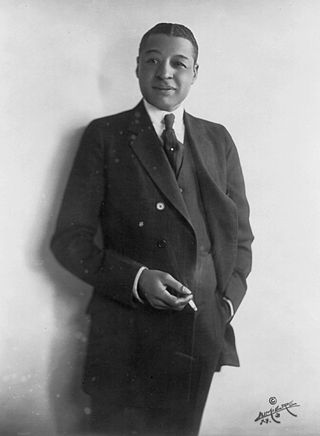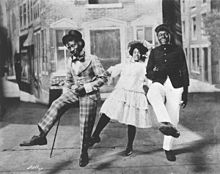
Bert Williams was a Bahamian-born American entertainer, one of the pre-eminent entertainers of the vaudeville era and one of the most popular comedians for all audiences of his time. While some sources have credited him as being the first Black man to have a leading role in a film with Darktown Jubilee in 1914, other sources have credited actor Sam Lucas with this same distinction for a different 1914 film, the World Film Company's Uncle Tom's Cabin. Ebony stated that "Darktown Follies was the first attempt of an independent film company to star a black actor in a movie", and credited the work as beginning a period in independent American cinema that explored "black themes" within works made for African-American audiences by independent producers.

Noble Lee Sissle was an American jazz composer, lyricist, bandleader, singer, and playwright, best known for the Broadway musical Shuffle Along (1921), and its hit song "I'm Just Wild About Harry".

Abriea "Abbie" Mitchell Cook, also billed as Abbey Mitchell, was an American soprano opera singer. She performed the role of Clara in the premiere production of George Gershwin's Porgy and Bess in 1935, and was also the first to record "Summertime" from that musical.

William Mercer Cook, better known as Will Marion Cook, was an American composer, violinist, and choral director. Cook was a student of Antonín Dvořák. In 1919 he took his New York Syncopated Orchestra to England for a command performance for King George V of the United Kingdom, and tour. Cook is probably best known for his popular songs and landmark Broadway musicals, featuring African-American creators, producers, and casts, such as Clorindy, or The Origin of the Cake Walk (1898) and In Dahomey (1903). The latter toured for four years, including in the United Kingdom and United States.

African-American musical theater includes late 19th- and early 20th-century musical theater productions by African Americans in New York City and Chicago. Actors from troupes such as the Lafayette Players also crossed over into film. The Pekin Theatre in Chicago was a popular and influential venue.
"Nobody" is a popular song with music by Bert Williams and lyrics by Alex Rogers, published in 1905. The song was first publicly performed in February 1906, in the Broadway production Abyssinia. The show, which included live camels, premièred at the Majestic Theater and continued the string of hits for the vaudeville team of Williams and Walker.

George Walker was an American vaudevillian, actor, and producer. In 1893, in San Francisco, Walker at the age of 20 met Bert Williams, who was a year younger. The two young men became performing partners. Walker and Williams appeared in The Gold Bug (1895), Clorindy (1898), The Policy Player (1899), Sons of Ham (1900), In Dahomey (1903), Abyssinia (1906), and Bandanna Land (1907). Walker married dancer Ada Overton, who later also was a choreographer.

Aida Overton Walker, also billed as Ada Overton Walker and as "The Queen of the Cakewalk", was an American vaudeville performer, actress, singer, dancer, choreographer, and wife of vaudevillian George Walker. She appeared with her husband and his performing partner Bert Williams, and in groups such as Black Patti's Troubadours. She was also a solo dancer and choreographer for vaudeville shows such as Bob Cole, Joe Jordan, and J. Rosamond Johnson's The Red Moon (1908) and S. H. Dudley's His Honor the Barber (1911).

George Washington Lederer was an American producer and director on Broadway from 1894 to 1931. He was the husband of actresses Reine Davies and Jessie Lewis and the father of Charles Lederer, Pepi Lederer, Glory Lederer and Geraldine Lederer.

Anita Bush was an African American stage actress and playwright. She founded the Anita Bush All-Colored Dramatic Stock Company in 1915, a pioneering black repertory theatre company that helped gain her the moniker "The Little Mother of Colored Drama".

Clorindy, or The Origin of the Cake Walk is a one-act musical by composer Will Marion Cook and librettist Paul Laurence Dunbar.

Jesse Allison Shipp, Sr. was an American actor, playwright, and theatrical director, who is best remembered as a pioneer African-American writer of musical theater in the United States, and as the author of the book upon which the landmark play In Dahomey was based. Shipp played an influential role in expanding black theater beyond its minstrel show origins and is recalled as perhaps the first African-American director of a Broadway performance.

Pete George Hampton was an American vocalist, harmonicist, banjo player, and vaudevillian from Bowling Green, Kentucky. He was part of various Vaudeville groups of which the most important was his own Darktown Entertainers. In 1903 he starred in the landmark Broadway musical In Dahomey, a work which he had toured in previously the year prior. He made more than 150 recordings during his career in the United Kingdom and Germany between 1903 and 1911. In 1904, he made the first harmonica recording by an African American, regarded as a pioneering example in the development of the blues harmonica style.

George Walker and Bert Williams were two of the most renowned figures of the minstrel era. However the two did not start their careers together. Walker was born in 1873 in Lawrence, Kansas. His onstage career began at an early age as he toured in black minstrel shows as a child. George Walker became a better known stage performer as he toured the country with a traveling group of minstrels. George Walker was a "dandy", a performer notorious for performing without makeup due to his dark skin. Most vaudeville actors were white at this time and often wore blackface. As Walker and his group traveled the country, Bert Williams was touring with his group, named Martin and Selig's Mastodon Minstrels. While performing with the Minstrels, African American song-and-dance man George Walker and Bert Williams met in San Francisco in 1893. George Walker married Ada Overton in 1899. Ada Overton Walker was known as one of the first professional African American choreographers. Prior to starring in performances with Walker and Williams, Overton wowed audiences across the country for her 1900 musical performance in the show Son of Ham. After falling ill during the tour of Bandana Land in 1909, George Walker returned to Lawrence, Kansas where he died on January 8, 1911. He was 38.

Bandanna Land is a musical from 1908. The book was written by Jesse A. Shipp, lyrics by Alex Rogers and music composed primarily by Will Marion Cook. Created by and featuring African Americans, it was the third musical written by the team whose previous works included In Dahomey (1902) and Abyssinia (1906). It was the last show featuring the duo of Bert Williams and George Walker, comedians who starred in these musicals. Walker became ill during the post-Broadway tour and died in 1911.
Daisy Tapley (1882–1925) was a classical singer (Contralto) and vaudeville performer. Born Daisy Robinson in Big Rapids, Michigan, she was raised in Chicago, where she played piano and the organ with music teachers Emil Liebling, Clarence Eddy, and later with Pedro Tinsley. At age twelve She became the featured organist at Chicago's Quinn Chapel as a musical prodigy. As a teenager, Robinson began training her voice after listening to recordings of the British contralto, Clara Butt. Daisy made history on December 7, 1910, when she became the first African American female to be recorded commercially, in a duet with Carroll Clark.
James J. Vaughan, also known as James Vaughn (1870–1935), was a composer, musical director, and bandleader in the United States. He wrote music for several musicals. He was among the first African-American musicians to play at Carnegie Hall in 1912.

Alexander Claude Rogers, known as Alex Rogers, was a composer and lyricist. He wrote music including for the musical Bandanna Land and served as president and a board member of the Gotham-Attucks Music Publishing Company. The firm published some of his songs.
Julius Hurtig was an American vaudeville and theatre producer.

Charlotte Louise Johnson, known as Lottie Williams and Lottie Thompson, was an American actress, singer, and dancer. A pioneering performer in African-American musical theater, she is best remembered for starring in several stage works with her second husband, Bert Williams, both on Broadway and in vaudeville. These included several musicals created by composer Will Marion Cook, lyricist Paul Laurence Dunbar, and the playwright Jesse A. Shipp; including Sons of Ham (1900), In Dahomey (1903), and Abyssinia (1906) among other works. In these musicals she portrayed mainly supporting character roles and was usually a featured singer and/or dancer. However, she portrayed the title role and the main protagonist in the Cook, Dunbar, and Shipp musical My Tom-Boy Girl (1905).




















